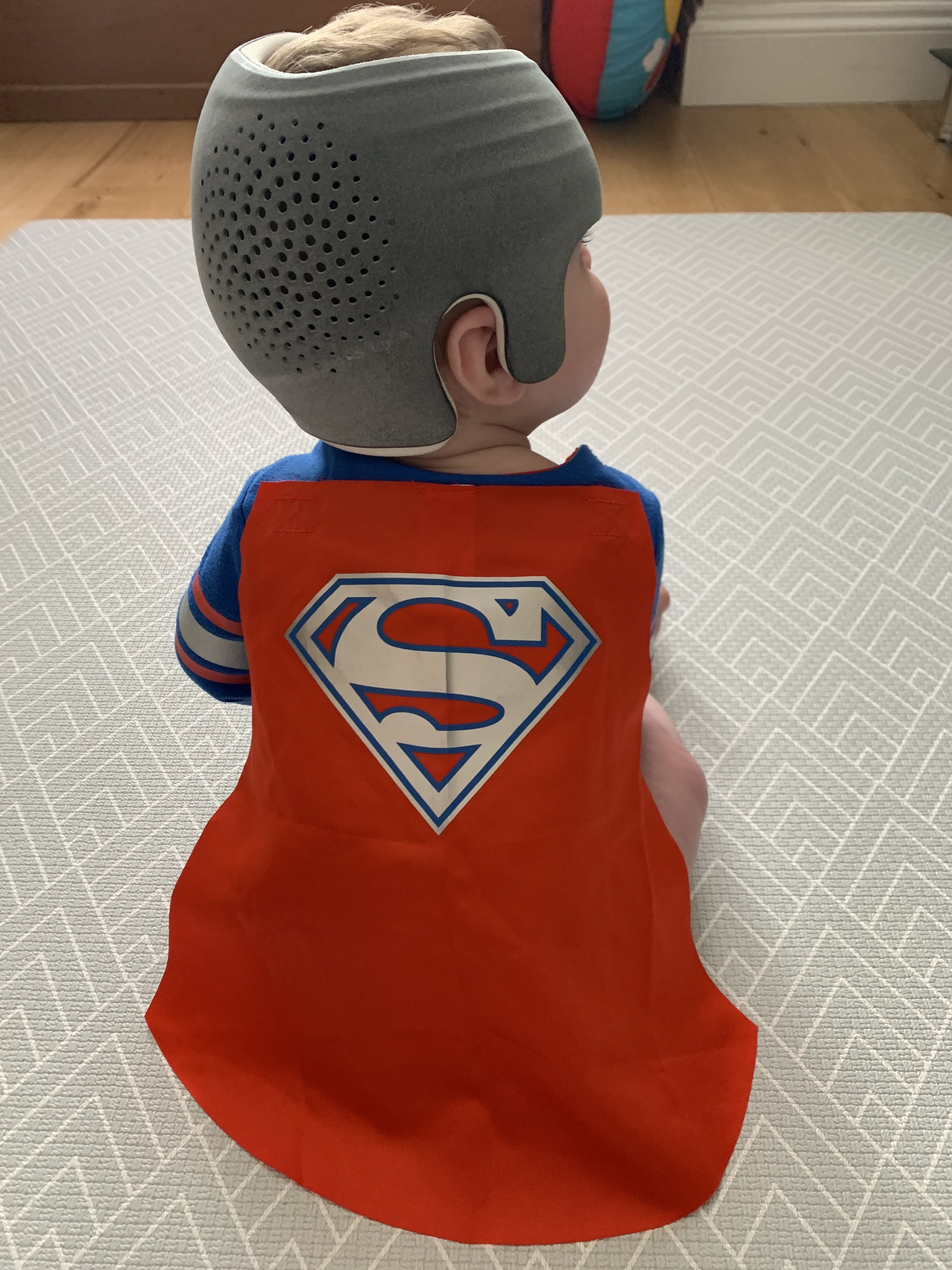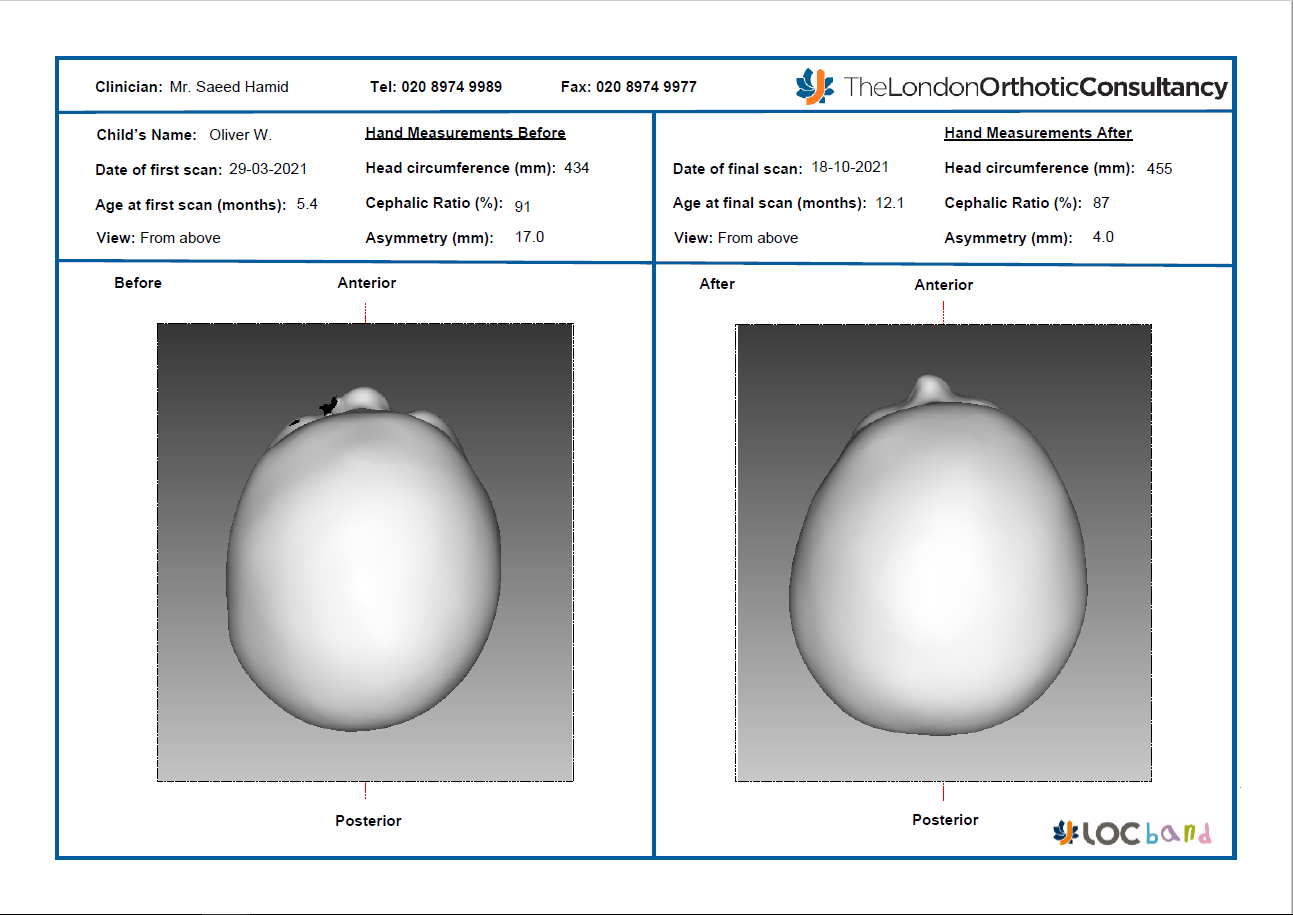
Super Ollie at home
10 January 2022
Oliver (Ollie to friends) was born with torticollis, a condition in which the neck muscles are tight and shorter, causing a head tilt and weakness on one side. Babies with this condition tend to sleep on one side and this can lead to a flattening of the head. To help him with this condition, Oliver’s mum and dad (Megan & Ashley) decided to see a paediatrician and a baby physio for some daily stretches.
After a couple of months, they noticed his head shape had improved but they still had concerns about the flattening at the posterior right-hand side of his head. It was at this point that they started researching online and they came across the LOCband treatment which had been referred to by their paediatrician.
Obviously, both parents were new to the treatment and wanted to have the best care for their baby, so they called LOC and booked a free consultation. Ollie was initially seen by Anna Courtney (one of LOC’s senior clinicians) in our Kingston clinic. At this stage, LOC was still trialling the LOCband Lite, a next-generation 3D printed helmet, which is 40% lighter than the original helmet with a reduced amount of plastic and better ventilation. When Anna said they could have either helmet, Megan and Ashley were pleased to have the option of a lighter version.

The helmet fitting was scheduled to be in our LOC’s Romford Clinic, to ease the travelling time for Megan & Ashley. The LOCband treatment at this clinic is provided by Saeed Hamid, a director of LOC and head of Plagiocephaly care. Megan explained “The first week was a bit of a transition for us, and unfortunately, we got the date wrong, and we showed up a day early. Saeed didn’t have the 3D printed helmet yet, so he provided the traditional LOCband. It was quite a hot week, Ollie found the helmet made him sweaty, nervous and it was a hard week on all of us. We got through that first week and then Ollie had his LOCband Lite helmet fitted; this helmet was life changing, being way lighter and more ventilated, Ollie got used to it really quickly without any problems”.
Megan added: “During the summer months we travelled to America and Saeed was incredibly flexible, offering us virtual reviews for our baby’s 3D helmet. Ollie’s journey with the helmet was surprisingly good. The quick improvements in his head shape made us feel so relieved. Choosing the best care for our baby was so important to us.”
Megan and Ashley were actually a bit reluctant to stop treatment, Ollie had a temperature and had to stop wearing the helmet during the last period of treatment, so they thought there could still have been a small chance for further improvement. At the last appointment, Saeed reassured Megan & Ashley regarding Ollie heads’ shape. After 5 months of treatment, Ollie’s head shape had gone from 17mm to 4 mm asymmetry, a really dramatic improvement leaving Megan & Ashley super happy about the results.
To help raise awareness of why babies sometimes need helmets, Megan & Ashley would strongly recommend that parents take the time to fully research the subject.
Are you worried about your baby’s head shape? Rea can get more information on positional plagiocephaly here. If you would like to book a free consultation with a LOC orthotist, just contact LOC.
This is very much dependent on how fast your baby is growing. The faster the growth, the more frequently your baby will be seen so that the helmet can be adjusted. In general, reviews will happen at two to four-week intervals.
The price of treatment covers:
Yes - All babies that have completed their course of treatment with us have achieved a measurable improvement in head shape. However, you don’t have to take our word for it.
Recent independent research conducted by a University Hospital in Germany has endorsed the treatment for babies with moderate or severe plagiocephaly.
A larger, retrospective study has just been published that found complete correction was achieved in 94.4% of babies treated with helmet therapy.
The results were conclusive: repositioning achieved acceptable correction in 77.1% of cases, but 15.8% were moved onto helmet therapy because re-positioning was not working. Meanwhile, 94.4% of the infants who started in the helmet-treated group achieved full correction, as did 96.1% of those who were transferred from the repositioning group into the helmet-treated group.
Further information can be found on our Plagiocephaly Research page.
If your baby has a temperature or a fever due to illness you must remove the band. The band can be put back on once the temperature has returned to normal.
The optimum age for treatment is between four and seven months.
This is because the skull is most malleable at this age and improvements to head shape tend to take less time and are more dramatic. That is not to say that helmet therapy should be ruled out if the baby is older than seven months. Routinely, babies up to the age of 16 months can be treated very successfully.
The cut off age is around 18 months when the fontanelles (soft spots on the head) are no longer malleable. As babies grow and develop at different rates, it is always worth checking if you are not sure. There have been cases where a baby’s fontanelles have not fused yet by the age of 18 months, who have achieved successful, but less-marked results with cranial remoulding therapy.
Torticollis is a condition in which a tight or shortened muscle in one side of the neck causes the head to tilt or turn to one side, resulting in the infant resting its head in the same position. In 2013, we analysed the data from all first appointments in our Kingston clinic and found that 20% of the babies examined had some kind of neck condition that was causing head immobility.
The clinics and clinicians that provide this treatment in the UK will have received similar training and experience. However, we are the only clinic that manufactures its own helmet and our clinicians are closely involved with the process for each individual helmet that we produce.
In addition, we do not restrict review appointments to a set number, we are extremely flexible and respond to individual parents' needs so that the best outcome can be achieved for each baby.
The LOCband is non-invasive and works by applying gentle, constant pressure over the areas of the baby’s skull that are most prominent while allowing unrestricted growth over the flattened areas. The band consists of a soft foam layer inside a thermoplastic shell. As the baby grows, the band will be adjusted frequently to gently guide the skull into a more symmetrical shape.